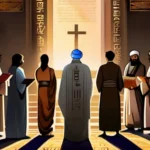Explore the key differences between the two major sections of the Christian Bible, their historical contexts, and their significance.
The Bible is a complex and rich text that has shaped human history for millennia. At its core are two main sections: the Old Testament and the New Testament. In this article, we will delve into the differences between these two sections, shedding light on their historical contexts, themes, and significance.
The Historical Context of the Old Testament
The Old Testament, like a towering ancient mountain, stands as a testament to history and faith. But just as one might climb different peaks for varied vistas, each section of this sacred text offers unique perspectives on humanity’s journey. How did it all begin? To understand its origins, we must first look back into the mists of time.
The Old Testament emerged from the rich tapestry of ancient Near Eastern cultures, particularly those found in Israel and surrounding regions like Egypt and Mesopotamia. Imagine a vast landscape where gods were many and kings ruled with absolute authority. How did this world transition into one where one God was central to life? The stories within the Old Testament provide us with clues.
Key events such as the Exodus from Egypt, the establishment of the Israelite kingdom under David, and the eventual division of the kingdom reflect significant turning points in ancient history. These events are more than just narratives; they symbolize transitions from oppression to freedom, from chaos to order. How did these stories shape not only the beliefs but also the political and social structures of their time?
The Old Testament is like a river that flows through different valleys, each adding its unique flow to the narrative. From the patriarchal tales of Abraham, Isaac, and Jacob to the prophetic voices warning against apostasy, these stories paint a complex picture of human nature and divine guidance. How do these stories resonate with us today? Are they merely historical accounts or do they hold timeless lessons?
As we explore further into the Old Testament, we’ll uncover its structure and contents in detail. But for now, let’s ponder: amidst the tapestry of these ancient stories, what threads stand out to you as most significant?
The Structure and Contents of the Old Testament
The Old Testament, often referred to as the ‘first testament’ or ‘covenant,’ forms the backbone of Christian theology and scripture. It’s like the blueprint for the New Testament, providing a rich tapestry of history, law, prophecy, and moral teachings.
Imagine opening a grand library; the Old Testament is akin to its ancient section, filled with scrolls of wisdom and stories that span centuries. It begins with the creation of the world in Genesis, painting a picture of humanity’s origins and the early days of God’s chosen people, the Israelites. How could we possibly understand the complexity of human nature without these initial chapters?
As you move through the Old Testament, you encounter a diverse range of books, each telling its own unique story. The Pentateuch, or the first five books (Genesis, Exodus, Leviticus, Numbers, and Deuteronomy), are like the foundation stones upon which everything else is built. They outline the laws and commandments given by God to Moses, setting ethical standards for a community.
Moving on, you come across prophetic books such as Isaiah, Jeremiah, and Ezekiel. These are like warnings in the night sky, illuminating the path forward with signs of coming events and calls for repentance. The wisdom literature, including Proverbs and Ecclesiastes, offers practical advice and reflections on life’s challenges, much like a trusted mentor guiding you through difficult times.
The historical books, such as Samuel, Kings, and Chronicles, recount the rise and fall of kingdoms, the triumphs and trials of faith. These stories are not just about the past; they resonate with our present struggles, reminding us that even in darkness, there is always hope.
Through all these books, the Old Testament weaves a narrative of God’s enduring covenant with humanity, promising salvation and redemption through Jesus Christ. It’s like watching a play unfold, where each act prepares the stage for the climax of salvation history in the New Testament.
The Historical Context of the New Testament
The New Testament emerges from a world drastically different from that of the Old Testament, much like a new chapter in a book filled with old stories. Imagine the Old Testament as a thick tome detailing the origins and development of a people—Israel. Now, picture the New Testament as a fresh volume, telling tales of transformation and renewal.
Historically speaking, the New Testament dates back to approximately 70 AD, post-Jesus’ crucifixion, with the final book being written around 100 AD. It was born out of the early Christian community, which sought to understand Jesus in light of their own experiences and the challenges they faced.
One might wonder why the New Testament came about. Was it simply a continuation of the Old Testament narrative or something entirely new? The answer lies in the heart of apostolic witness. Early Christians needed guidance on how to live out their faith, and so the New Testament was born from the teachings and experiences of apostles like Paul, John, and Matthew.
The historical context is crucial here. The Roman Empire’s rule over diverse regions brought about a melting pot of cultures. This environment heavily influenced early Christian writings. For instance, the letter to the Romans (written by Paul) navigates cultural differences within the empire, advocating for unity in Christ.
Moreover, the New Testament reflects the struggle and triumphs of early Christians as they faced persecution. The book of Acts, for example, chronicles the spread of Christianity amidst Roman oppression, highlighting the resilience of those who believed in a message of love and equality.
The historical context of the New Testament is like a thread that weaves through the fabric of its texts, connecting ancient struggles with modern ones. As readers, we must not only read these words but also reflect on their timeless relevance to our own lives today. How do the teachings of the apostles resonate in our world? What lessons can we learn from their experiences?
Understanding this context helps us grasp that the New Testament isn’t just a collection of ancient stories, but a living document that continues to shape Christian life and thought. It’s a testament to the ongoing journey of faith, always adapting to new environments while holding onto core beliefs.
The Structure and Contents of the New Testament
The New Testament, like its older counterpart, the Old Testament, carries a rich tapestry of stories, teachings, and beliefs that shape Christian understanding. But what exactly sets these two books apart? Let’s dive into the structure and contents of the New Testament, asking ourselves: What makes this section so distinctive?
Firstly, the New Testament opens with the Gospels, which tell the story of Jesus Christ’s life, ministry, death, and resurrection. These four narratives—Matthew, Mark, Luke, and John—are like a mosaic, each providing unique insights into the same puzzle of Jesus’ mission.
Imagine you have a box of crayons, with each one representing a different Gospel. Matthew might be the bright red—one of vibrant color and rich detail. Mark could be the sharp black, sketching quick, bold strokes. Luke offers the softer greens and blues, painting scenes in depth and context. And John shines like a shimmering gold, filled with profound revelations.
After these colorful narratives come the Apostolic Letters, or epistles, written by the apostles to early Christian communities. These letters offer guidance on faith, morals, and church governance, much like a compass guiding travelers through uncharted territories. Think of them as the blueprints for building the Christian community.
Finally, we have the Apostolic Revelation, best known as the book of Revelation. This last section is often shrouded in mystery and awe, like a veiled prophecy that speaks of future events. It’s the dreamy night sky, painting vivid pictures of heaven and earth intertwined.
The structure and contents of the New Testament thus form a compelling narrative arc, from the birth of Christianity to its spread and the vision for its future. Each book, each chapter, is a piece in this vast jigsaw puzzle, offering guidance, inspiration, and insight into the heart of Christian belief.
Comparing the Old Testament and the New Testament
When we talk about the Old Testament (OT) and the New Testament (NT), it’s like comparing two vast libraries, each holding its own unique stories and messages. The OT is often seen as a collection of ancient laws and prophecies, while the NT brings us into a realm of new beginnings and divine teachings. Have you ever wondered why these two sections are so distinct yet interconnected?
Imagine the OT as the blueprint for a city, carefully designed with detailed instructions on how to build it. This blueprint sets the foundation, detailing the history, culture, and laws of the chosen people. The books here include stories of creation, conquests, and the establishment of a nation under God’s watchful eye. It’s like having the blueprints for an entire civilization laid out before us.
On the other hand, the NT can be seen as the actual city itself – vibrant, bustling with life, and filled with new meanings and interpretations. This section introduces Jesus Christ and his teachings, transforming concepts of law into love. The New Testament shifts from a focus on rituals to an emphasis on personal faith and ethical living. It’s like stepping into a fully constructed city, where the blueprints come alive in stories of hope, redemption, and the fulfillment of ancient prophecies.
Both sections are essential for understanding each other. The OT provides context and background, explaining why Jesus came and what he was addressing. Without the Old Testament’s rich tapestry of history and prophecy, much of the New Testament would be difficult to grasp fully. They complement each other beautifully, like a book that tells both the story and its culmination.
From a historical perspective, the OT covers events from the time of creation up until the coming of Christ, while the NT picks up where the OT leaves off, focusing on the life, teachings, death, and resurrection of Jesus. Both sections are crucial in understanding the overarching narrative of God’s plan for humanity.
So, as we explore these two monumental collections, remember that they stand together like two sides of a coin – one side bearing ancient traditions, and the other, fresh and enlightening teachings. Each section enriches our understanding of the other, making it impossible to appreciate either without the context provided by the other.
Understanding the differences between the Old Testament and the New Testament is not just about knowing their distinct contents; it’s about grasping how they work together to form a cohesive and profound story. This interplay between ancient wisdom and new revelation shapes our faith and guides us through the complexities of understanding God’s enduring love for humanity.
The Impact of the Old Testament and the New Testament on Western Civilization
How has Western civilization been shaped by the Old Testament and the New Testament? These two major sections of the Christian Bible have left indelible marks on our literature, art, philosophy, and religion. Imagine, for a moment, the Old Testament as an ancient cornerstone, solid and enduring, while the New Testament is like a vibrant new leaf, delicate yet full of promise.
The Old Testament, with its rich tapestry of stories, laws, and prophecies, has deeply influenced Western literature. Think about how many literary works have been inspired by characters such as David and Goliath or the exodus from Egypt. These narratives are not just religious texts but also powerful metaphors for personal growth and societal change. Can you imagine a world without the timeless themes of good versus evil, redemption, and divine providence found in these ancient tales?
Art, too, has been profoundly impacted by both testaments. From the grand frescoes depicting scenes from the Old Testament’s battlefields to the serene depictions of the New Testament’s life of Jesus, each page of scripture provides a canvas for artists’ imaginations. The New Testament, with its focus on love and forgiveness, has led to some of the most moving representations in art history, questioning the very nature of humanity and our relationship with divinity.
In philosophy, these texts have laid the groundwork for ethical and moral discussions that continue to shape Western thought. From the Ten Commandments to Jesus’ teachings, they offer a framework for understanding right from wrong, influencing everything from legal systems to personal ethics. Could we imagine a world without the influence of these ancient yet timeless principles?
Lastly, it is impossible to overstate the religious significance of both testaments in Western society. The Old Testament provides the historical and cultural context that defines Judaism and influences Christian theology, while the New Testament offers a narrative of salvation and transformation. Together, they form a bridge between faith and reason, guiding believers through life’s most profound questions.
Reflecting on these impacts, it’s clear that the Old and New Testaments have not just influenced but transformed Western civilization. They are more than mere books; they are living forces that continue to shape our understanding of the world around us.
Conclusion
 By understanding the differences between the Old Testament and the New Testament, we gain a deeper appreciation for the Bible as a whole and its impact on Western civilization. We hope this article has provided you with valuable insights into these two important sections of the Christian Bible.
By understanding the differences between the Old Testament and the New Testament, we gain a deeper appreciation for the Bible as a whole and its impact on Western civilization. We hope this article has provided you with valuable insights into these two important sections of the Christian Bible.











